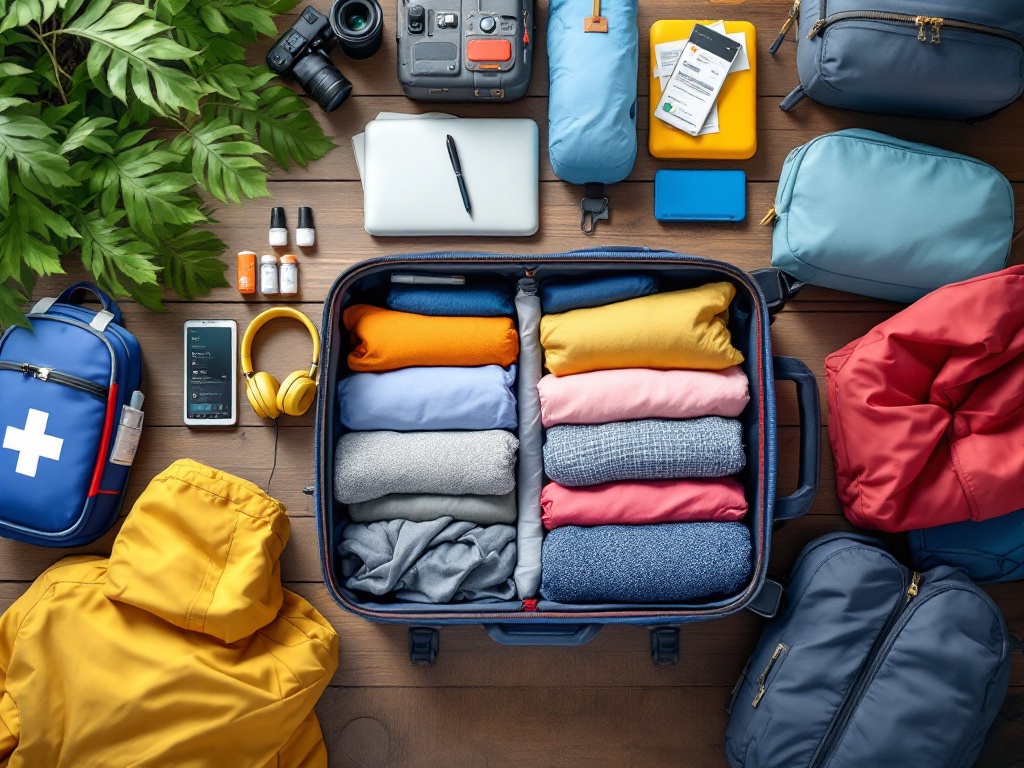Packing Smart for Student Trips: Essentials You Shouldn’t Forget
Headed on a student trip? Avoid overpacking stress and forgotten essentials with our smart packing guide! Learn how to maximize space with rolling techniques and packing cubes, create a foolproof checklist, and pack versatile clothing for any weather. Discover essential items like travel documents, basic medications, and tech must-haves. Start your adventure prepared and stress-free – read on to pack like a pro!
Important information

- Plan ahead and make a categorized packing list to stay organized and avoid forgetting essentials. Double-check it before you leave.
- Pack light by rolling clothes, using packing cubes or compression bags, and wearing bulky items while traveling.
- Prioritize essential toiletries, medications, important documents (like passport and ID), and electronics (phone and charger).
- Bring a reusable water bottle to stay hydrated and pack snacks for convenience.
- Check the weather forecast before your trip and adjust your clothing choices accordingly. Choose comfortable and appropriate footwear.
Smart Packing Tips for Student Trips
Pack smart for your student adventure with this comprehensive checklist!
Create a pre-trip checklist. Categorize items into groups like clothing, toiletries, and electronics to stay organized.
Prioritize essentials based on your trip’s duration to prevent overpacking.
Visualize packed items by laying them out on your bed or floor to track progress.
Check off each item as you pack to avoid forgetting anything. Review your list the day before your trip for any last-minute additions.
Roll your clothes instead of folding to save space and minimize wrinkles. Use packing cubes or compression bags to maximize space and maintain tidiness.
Pack versatile clothing items to reduce the overall number of items you need. Wear your bulkiest items during travel, like your heaviest jacket, to conserve luggage space.
Be mindful of bag weight limits to avoid airport fees. Keep frequently used items easily accessible at the top of your luggage.
What to Include in Your Packing List
Choose appropriate clothing based on the weather and your itinerary.
Pack essential toiletries, medications, and a first-aid kit.
Remember electronics such as your phone and charger.
Bring a reusable water bottle to stay hydrated.
Pack snacks and a lightweight backpack for day trips.
A journal is great for documenting your experiences.
Don’t forget crucial documents such as your ID, tickets, and travel insurance.
How to Stay Organized with a Travel Bag
Packing cubes are excellent for organizing your luggage, neatly separating clothes, toiletries, and electronics, which makes finding things a breeze. A packing list is also crucial, ensuring you don’t leave any essentials behind. Categorizing this list by item type, such as grouping all clothing together and all toiletries, further streamlines the packing process. Double-checking your list is always a good idea.
Benefits of Packing Cubes
- Organize luggage efficiently.
- Separate clothes, toiletries, and electronics neatly.
- Make finding items easier.
Tips for Using a Packing List
- Ensure you don’t forget essential items.
- Categorize items by type for easier packing.
- Double-check your list before leaving.
With packing cubes and a well-organized list, your travels will be much smoother.
Essential Items to Pack for Student Trips
When packing, prioritize toiletries and prescription medications, as these can be costly to replace abroad.
Pack essential personal hygiene items and a reusable water bottle to stay hydrated.
Remember your travel documents, cash, and credit cards.
For international travel, bring a copy of your passport.
A small first-aid kit with basic medications can be helpful.
Hygiene Items and Prescriptions
When packing, remember your toiletries: toothpaste, toothbrush, shampoo, conditioner, soap, and deodorant. Crucially, bring any prescription medications and a first-aid kit stocked with pain relievers and antiseptic wipes. For outdoor adventures, sunscreen and insect repellent are vital. Female students should also pack feminine hygiene products.
- Toiletries: toothpaste, toothbrush, shampoo, conditioner, soap, and deodorant.
- Medications: prescription medications.
- First-Aid Kit: pain relievers and antiseptic wipes.
- Outdoor Essentials: sunscreen and insect repellent.
- Feminine Hygiene products.
Travel Documents, Cash, and Credit Cards
Gather essential documents like your government-issued ID, transportation tickets, and travel insurance information.
Students should pack medical forms and permission slips.
Bring cash and credit cards for expenses.
Store these items securely and accessibly, using a checklist and travel pouch for organization.
Create photocopies or digital backups of important documents for safekeeping.
Copy of Your Passport for International Travel
A passport copy is essential for international travel, serving as a backup ID if your original is lost or stolen. This can significantly expedite replacement, helping verify your identity and report the loss to local authorities. Therefore, always copy your passport before traveling and store it separately.
Importance of Basic Medications
Traveling students should pack essential medications. International drug prices can vary significantly, so bringing your own saves money. Common over-the-counter remedies can be surprisingly expensive abroad. Research your destination’s medication import regulations. Ensure medications are clearly labeled to avoid customs issues. This preparation contributes to a healthier, more affordable trip.
Reusable Water Bottle for Hydration
Staying hydrated is essential for any student trip, and a reusable water bottle is a great way to achieve that. It not only keeps you refreshed, but also helps reduce plastic waste and saves you money. Refilling is definitely more economical than constantly buying drinks.
Clothing and Footwear Recommendations
Pack smart for your trip by considering the destination’s climate and preparing for varied weather conditions. Layering is key, so pack versatile items like t-shirts, long-sleeved shirts, sweaters, and jackets. Comfortable pants and shorts are essential for everyday wear. Don’t forget a raincoat or poncho for unexpected downpours.
Footwear
Select footwear appropriate for your planned activities. Comfortable walking shoes are recommended for general sightseeing. If you plan on hitting the trails, hiking boots are ideal for support and protection. For water activities, pack water shoes to protect your feet and provide grip.
Other Essentials
Remember to pack extra socks for comfort and hygiene.
How to Choose Suitable Clothing for All Weather
Pack efficiently for your trip by considering these factors:
Climate and Activities
Research the local climate and your planned activities. Pack versatile, layered clothing made of breathable fabrics for warm climates. Thermal wear is essential for cold destinations. A waterproof jacket is always recommended.
Local Customs and Footwear
Consider local customs when choosing outfits. Comfortable walking shoes are ideal for city exploration. For trails and hikes, pack hiking boots. Ensure your shoes are appropriate for your itinerary.
Tips for Selecting Necessary Footwear
When preparing for your trip, consider the climate and your itinerary to pack appropriate footwear. For warm destinations, pack flip-flops or sandals for the beach or pool, but if you plan on trekking, sturdy hiking boots are essential. Always pack light on footwear.
Organized Packing for Efficient Travel
Packing cubes are a traveler’s best friend, compressing and organizing your belongings. Categorizing items makes finding them easy and maximizes luggage space.
Rolling clothes, rather than folding, is another space-saving trick. Tightly rolled items fit snugly, creating more room and helping organize by clothing type. This method also minimizes wrinkles.
For even more space, use compression bags. By removing excess air, they’re great for bulky items like sweaters, plus they protect clothes from moisture and wrinkles, making them a packing essential.
Maximizing Space with Packing Cubes
Packing cubes are a traveler’s best friend for maximizing luggage space. By efficiently dividing clothes and belongings, these handy organizers compress items, creating extra room. This also keeps everything neat and tidy, so travelers can quickly locate what they need without unpacking their entire suitcase.
Rolling Clothes for Space Efficiency
Rolling your clothes saves valuable space and minimizes wrinkles. Packing cubes are another excellent organizational strategy, separating clean clothes from dirty ones to maintain freshness.
Utilizing Compression Bags
Compression bags are a traveler’s best friend for maximizing luggage space. By shrinking bulky items like sweaters and jackets, they free up significant room for other essentials. This allows travelers to pack more efficiently. Additionally, compression bags offer a convenient way to separate and compress dirty laundry for the return trip.
Technology and Safety Considerations
- A universal plug adapter will keep your devices powered up no matter the outlet.
- Your phone charger is essential for staying connected.
- Secure your belongings with luggage locks for peace of mind.
Universal Plug Adapter and Chargers
For stress-free travel, pack a universal plug adapter to handle outlets worldwide. Don’t forget chargers for your phone, laptop, and other electronics. These will keep your devices powered up, but a portable power bank offers extra reassurance (check airline rules first, though).
Phone and Phone Charger Necessities
Your phone and its charger are essential for staying connected and powered up. A portable charger is invaluable for longer journeys, ensuring uninterrupted usage. For international travel, remember a universal adapter to keep your devices charged wherever you go.
Safety Items: Locks on Luggage
Luggage locks enhance your bag’s security, deterring theft. Options include combination and keyed locks. For travel, TSA-approved locks are crucial, permitting inspections without damage.
Comfort and Convenience on the Go
Pack smart snacks like nuts, dried fruit, or protein bars to keep you satisfied between meals, especially during long journeys or unexpected delays. Granola bars offer a quick energy boost.
A travel pillow and blanket can also significantly improve comfort on flights or train rides, promoting relaxation and better sleep.
Snacks and Emergency Granola Bars
When packing snacks for your adventure, choose non-perishable, easy-to-carry options like granola bars, trail mix, dried fruit, or nut butter packets. These prevent spoilage and satisfy unexpected hunger. Remember to account for any dietary restrictions. Consider packing the following:
- Granola bars, a convenient and compact source of energy.
- Trail mix, a customizable blend of nuts, seeds, and dried fruit.
- Dried fruit, a lightweight and naturally sweet snack.
- Nut butter packets, a protein-rich option to keep you feeling full.
Comfort Items: Travel Pillow and Blanket
Travel pillows and blankets are essential for comfortable long journeys. They provide crucial neck and head support, promoting better sleep and reducing travel fatigue. A compact, inflatable pillow is a great option, easily attaching to your luggage. For added warmth and comfort, a lightweight, packable blanket is invaluable. These items are true travel companions, ensuring a more pleasant trip.
Benefits of Travel Pillows
- provide crucial neck and head support,
- promote better sleep,
- reduce travel fatigue.
Benefits of Travel Blankets
- provide added warmth and comfort,
- lightweight and packable,
- ensure a more pleasant trip.
Final Preparations Before Departure
Before heading out, check the weather forecast for your destination to ensure you are prepared. Review your packing list to avoid leaving any essentials behind.
Last-Minute Weather Check
Check the weather forecast before your trip to pack suitable clothes and accessories.
Final Check of Packing List
Before you embark on your journey, meticulously review your packing list. Confirm that you have included essential items such as travel documents, medications, electronics, appropriate clothing, and footwear. Consider your destination and planned activities – do you need specialized gear or equipment? This final check helps prevent leaving behind crucial items.













